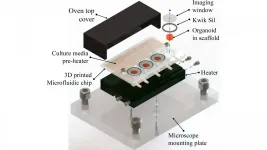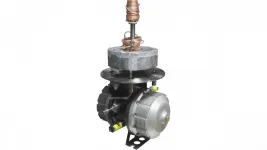Tiny brains grown in 3D-printed bioreactor
Small device contains wells to let small bits of tissue grow, develop, and be studied in real time
2021-04-06
(Press-News.org) WASHINGTON, April 6, 2021 -- Scientists from MIT and the Indian Institute of Technology Madras have grown small amounts of self-organizing brain tissue, known as organoids, in a tiny 3D-printed system that allows observation while they grow and develop. The work is reported in Biomicrofluidics, by AIP Publishing.
Current technology for real-time observation of growing organoids involves the use of commercial culture dishes with many wells in a glass-bottomed plate placed under a microscope. The plates are costly and only compatible with specific microscopes. They do not allow for the flow or replenishment of a nutrient medium to the growing tissue.
Recent advances have used a technique known as microfluidics, where a nutrient medium is delivered through small tubes connected to a tiny platform or chip. These microfluidic devices are, however, expensive and challenging to manufacture.
The current advance uses 3D printing to create a reusable and easily adjustable platform that costs only about $5 per unit to fabricate. The design includes imaging wells for the growing organoids and microfluidic channels to provide a nutrient medium and preheating that supports tissue growth.
A biocompatible type of resin used in dental surgery was used for the 3D-printed device. The printed chip was cured by exposing it to UV light, then sterilized before live cells were placed in the wells. After sealing the top of the wells with a glass slide, the nutrient medium and drugs for use in the study were added through small inlet ports.
"Our design costs are significantly lower than traditional petri dish- or spin-bioreactor-based organoid culture products," said author Ikram Khan. "In addition, the chip can be washed with distilled water, dried, and autoclaved and is, therefore, reusable."
The investigators tested their device with organoids derived from human cells. They observed the growing brain organoids with a microscope and were able to successfully follow their growth and development for seven days. The small bit of brain tissue developed a cavity or ventricle surrounded by a self-organizing structure that resembles a developing neocortex.
The percentage of cells in the core of the organoid that died during this one-week period was smaller in the 3D-printed device than in regular culture conditions. The investigators believe that their cell design protects the tiny growing brain.
Khan said, "One advantage offered by our microfluidic device is that it allows constant perfusion of the culture chamber, which more closely mimics a physiological tissue perfusion than conventional culture, and thus reduces cell death at the organoid core."
The investigators hope to increase the capacity of their device by scaling up the number of available wells. Other improvements will allow for additional instruments to be integrated into the design.
INFORMATION:
The article "A low-cost 3D printed microfluidic bioreactor and imaging chamber for live-organoid imaging" is authored by Ikram Khan, Anil Prabhakar, Chloe Delepine, Hayley Tsang, Vincent Pham, and Mriganka Sur. The article will appear in Biomicrofluidics on April 6, 2021 (DOI: 10.1063/5.0041027). After that date, it can be accessed at https://aip.scitation.org/doi/10.1063/5.0041027.
ABOUT THE JOURNAL
Biomicrofluidics rapidly disseminates research in fundamental physicochemical mechanisms associated with microfluidic and nanofluidic phenomena. The journal also publishes research in unique microfluidic and nanofluidic techniques for diagnostic, medical, biological, pharmaceutical, environmental, and chemical applications. See https://aip.scitation.org/journal/bmf.
[Attachments] See images for this press release:

ELSE PRESS RELEASES FROM THIS DATE:
2021-04-06
WASHINGTON, April 6, 2021 -- Cryocoolers are ultracold refrigeration units used in surgery and drug development, semiconductor fabrication, and spacecraft. They can be tubes, pumps, tabletop sizes, or larger refrigerator systems.
The regenerative heat exchanger, or regenerator, is a core component of cryocoolers. At temperatures below 10 kelvins (-441.67 degrees Fahrenheit), performance drops precipitously, with maximum regenerator loss of more than 50%.
In their paper, published in Applied Physics Letters, by AIP Publishing, researchers at the University of Chinese Academy of Sciences used ...
2021-04-06
WASHINGTON, April 6, 2021 -- Dragonfly wings, lotus leaves, cicada wings -- thanks to millennia of evolution, nature has optimized the ways these surfaces and others behave to offer antibacterial functionality.
An international, interdisciplinary team of researchers is trying to find the best way to translate these features to create nature-inspired bactericidal surfaces for use in medical implants. They discuss the surface structures and chemical compositions for an ideal implant material in the journal Applied Physics Reviews, from AIP Publishing.
"Objects in ...
2021-04-06
What The Study Did: Researchers compared the effectiveness of case-based (including contact tracing and quarantine) and population-based (including social distancing and facial masking) interventions for COVID-19 containment in Taiwan, one of the few countries with initial success in COVID-19 control without strict lockdown or school closure.
Authors: Hsien-Ho Lin, M.D., Sc.D., of National Taiwan University in Taipei, Taiwan, is the corresponding author.
To access the embargoed study: Visit our For The Media website at this link https://media.jamanetwork.com/
(doi:10.1001/jamainternmed.2021.1644)
Editor's Note: The article includes conflicts of interest and funding/support disclosures. Please see the article for additional information, including ...
2021-04-06
What The Study Did: This study investigated the role of droplet or contact transmission in the development of Kawasaki disease in Japan during the COVID-19 state of emergency. Kawasaki disease primarily affects children and is characterized by fever and swelling in the walls of some blood vessels.
Authors: Toshiro Hara, M.D., Ph.D., of the Fukuoka Children's Hospital in Fukuoka, Japan, is the corresponding author.
To access the embargoed study: Visit our For The Media website at this link https://media.jamanetwork.com/
(doi:10.1001/jamanetworkopen.2021.4475)
Editor's Note: The article includes conflicts of interest and funding/support disclosures. Please see the article for additional information, ...
2021-04-06
What The Study Did: A model to prioritize vaccination was developed that estimates the risk of SARS-CoV-2-related death among enrollees in the Veterans Affairs health care system.
Authors: George N. Ioannou, B.M.B.Ch., M.S., of the Veterans Affairs Puget Sound Healthcare System in Seattle, is the corresponding author.
To access the embargoed study: Visit our For The Media website at this link https://media.jamanetwork.com/
(doi:10.1001/jamanetworkopen.2021.4347)
Editor's Note: The article includes conflicts of interest and funding/support disclosures. Please see the article for additional information, including other authors, author contributions and affiliations, conflict of interest and financial disclosures, and funding and support.
INFORMATION:
Media ...
2021-04-06
What The Study Did: The clinical and other characteristics of multisystem inflammatory syndrome in children in the United States, a condition that occurs in association with the COVID-19 pandemic, are described in this study.
Authors: Ermias D. Belay, M.D., of the Centers for Disease Control and Prevention in Atlanta, is the corresponding author.
To access the embargoed study: Visit our For The Media website at this link https://media.jamanetwork.com/
(doi:10.1001/jamapediatrics.2021.0630)
Editor's Note: The article includes conflict of interest ...
2021-04-06
WASHINGTON, April 6, 2021 -- With research increasingly showing the COVID-19 virus is transmissible via smaller droplets suspended in air, there is a growing concern current public health guidelines of mask wearing and social distancing are insufficient in combating its spread in indoor environments, like prisons, hospitals, and meatpacking plants, where people tend to be in close quarters.
Most research has focused on coughing and sneezing. But studies on how simply breathing might contribute to airborne spread of the virus are rare.
In AIP Advances, by AIP Publishing, researchers at the Indian Institute of Technology Bhubaneswar show social distancing is equally ...
2021-04-06
Spain is among the five countries in the world with the highest levels of social acceptance of LGBTIQ+ people and rights, and was the third country in the world to legalize same-sex marriages, in 2005. In 2019, 3.1% of marriages were between same-sex couples (INE 2020). In this context, it would seem consistent that sexual orientation should not determine wage inequalities. But is this really so? What is the relationship between sexual orientation and wages?
The study, recently published in Journal of Family Issues, found a significant correlation ...
2021-04-06
The Tibetan Plateau, known as "the roof of the world", has warmed more rapidly than global average in the past decades. The observed warming of the Tibetan Plateau since 1960s can be attributed to human activities, particularly greenhouse gas emissions. Moreover, the Plateau may warm faster in the future than climate models projected, according to a study recently published in Environmental Research Letters.
The Tibetan Plateau contains the largest volumes of ice outside the Arctic and Antarctic, feeding water to dozens of major Asian rivers. However, the rapid warming of the "Water Tower of Asia" has significantly affected regional hydrological cycle and ecosystem services, leading to remarkable glacier retreat and geohazard ...
2021-04-06
New research led by the universities of Kent and Warwick has found that, contrary to previous beliefs, adolescents born preterm have the same levels of self-esteem and overall wellbeing as those born full-term.
Preterm birth, defined as birth before 37 weeks of gestation, has been previously found to be associated with an increased risk for lower academic achievement, higher mental health problems and increased difficulties in social relationships compared to those born full-term. This new study, co-led by Dr Ayten Bilgin (Kent) alongside colleagues from Warwick, demonstrates that in contrast, preterm birth ...
LAST 30 PRESS RELEASES:
[Press-News.org] Tiny brains grown in 3D-printed bioreactor
Small device contains wells to let small bits of tissue grow, develop, and be studied in real time



